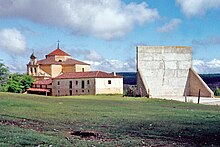Morale of Hornuez
Moral de Hornuez is a Spanish municipality and town in the province of Segovia, in the autonomous community of Castilla y León. It has a population of 45 inhabitants (INE 2022).
Geography
Located in the center of a circumference equidistant about 24 km from important towns in the area such as Sepúlveda, Riaza or Aranda de Duero, it is accessed by the SG-V-9322 highway; south from Fuentemizarra or north from Valdevacas, after crossing the Valdemiro stream
History
The first written manifestation of the existence of Moral de Hornuez dates from the XIII century, when the legend of the Virgin of Hornuez.
In 1568, Moral was mentioned in the Colegio Mayor de San Ildefonso de Alcalá de Henares as the origin of a student.
In real data, El Moral appears in the Census of the Crown of Castile of 1591. Located in the neighborhood of Segovia, it belonged to the Land of Maderuelo. It had 58 neighbors, of which 56 were pecheros and 2 clergymen. The places of Tamarón (unpopulated) and La Nava (2 neighbors), appear independent, being incorporated later.
The following manifestation is from 1787.
The Moral appears as Villa, with the authority of the Ordinary Mayor of Señorío, jurisdiction of Señorío Secular, segoviana mayor. It had 311 inhabitants (162 men and 142 women), distributed as follows: 1 priest, 1 sacristan, 1 hidalgo, 26 husbandmen, 6 artisans, 8 servants, 1 plaintiff and 267 women or no job.Floridablanca Census of 1787, p. 480
In Sebastián Miñano's dictionary (1827) it appears:
MORAL (EL), V.S. of Spain, province of Burgos, party of Aranda de Duero, jurisdiction of Maderuelo. A.O., 65 neighbors, 264 inhabitants, 1 parish. Sit. on the banks of the stream Caravias that dewaters in the Riaza river, beautiful with the villages of Caravia and Maderuelo. It produces grains, legumes, pastures and cattle. Dista 18 leagues of the capital. Contribute 3,326 rs. 24 mrs. Drec. enag. 419 rs. 15 mrs.
Belonging to the province of Burgos was due to an attempt to reform the provincial boundaries after the French invasion. (See History of the territorial organization of Spain)
In 1918 it was defined as:
Municipality of 272 buildings and 448 inhabitants. Formed by the villa of its name and 148 houses in small groups or scattered. It corresponds to the province and diocese of Segovia, judicial party of Riaza. Generally flat land; cereals, legumes and potatoes; cattle.Espasa Calpe Encyclopedia, 1918
In the 1960s it reached its maximum splendor, with 560 inhabitants. It belongs to the judicial party of Riaza. It was integrated into the community of villa and land of Maderuelo.
Symbols
- Shield
Under the royal crown, a divided coat of arms with the figure of a juniper (sabina) on the right and the image of a star raining down on the peninsula on the left.[citation required]
Demographics
| 2000 | 2002 | 2004 | 2006 | 2008 | 2010 | 2012 | 2014 | 2016 | 2018 | 2020 | |||||||||||||||||||||||||||||||||||||||||||||||||||||||||||||||||||||||||||||||||||||||||||||||||||||||||||||||||||||||||||||||||||||||||||||||||||||||||||||||||||||||||||||||||||||||||||||||||||||||||||||||||||||||||||||||||||||||||||||||||||||||||||||||||||||||||||||||||||||||||||||||||||||||||||||||||||||||||||||||||||||||||||||||||||||||||||||||||||||||||||||||||||||||||||||||||||||
|---|---|---|---|---|---|---|---|---|---|---|---|---|---|---|---|---|---|---|---|---|---|---|---|---|---|---|---|---|---|---|---|---|---|---|---|---|---|---|---|---|---|---|---|---|---|---|---|---|---|---|---|---|---|---|---|---|---|---|---|---|---|---|---|---|---|---|---|---|---|---|---|---|---|---|---|---|---|---|---|---|---|---|---|---|---|---|---|---|---|---|---|---|---|---|---|---|---|---|---|---|---|---|---|---|---|---|---|---|---|---|---|---|---|---|---|---|---|---|---|---|---|---|---|---|---|---|---|---|---|---|---|---|---|---|---|---|---|---|---|---|---|---|---|---|---|---|---|---|---|---|---|---|---|---|---|---|---|---|---|---|---|---|---|---|---|---|---|---|---|---|---|---|---|---|---|---|---|---|---|---|---|---|---|---|---|---|---|---|---|---|---|---|---|---|---|---|---|---|---|---|---|---|---|---|---|---|---|---|---|---|---|---|---|---|---|---|---|---|---|---|---|---|---|---|---|---|---|---|---|---|---|---|---|---|---|---|---|---|---|---|---|---|---|---|---|---|---|---|---|---|---|---|---|---|---|---|---|---|---|---|---|---|---|---|---|---|---|---|---|---|---|---|---|---|---|---|---|---|---|---|---|---|---|---|---|---|---|---|---|---|---|---|---|---|---|---|---|---|---|---|---|---|---|---|---|---|---|---|---|---|---|---|---|---|---|---|---|---|---|---|---|---|---|---|---|---|---|---|---|---|---|---|---|---|---|---|---|---|---|---|---|---|---|---|---|---|---|---|---|---|---|---|---|---|---|---|---|---|---|---|---|---|---|---|---|---|---|---|---|---|---|---|---|---|---|---|---|---|---|---|---|---|---|---|---|---|---|---|---|---|---|---|---|---|---|---|---|---|---|
| 105 | 102. | 93 | 100 | 101 | 93 | 82 | 73 | 64 | 54 | 49 | |||||||||||||||||||||||||||||||||||||||||||||||||||||||||||||||||||||||||||||||||||||||||||||||||||||||||||||||||||||||||||||||||||||||||||||||||||||||||||||||||||||||||||||||||||||||||||||||||||||||||||||||||||||||||||||||||||||||||||||||||||||||||||||||||||||||||||||||||||||||||||||||||||||||||||||||||||||||||||||||||||||||||||||||||||||||||||||||||||||||||||||||||||||||||||||||||||||
| (Source: INE) | |||||||||||||||||||||||||||||||||||||||||||||||||||||||||||||||||||||||||||||||||||||||||||||||||||||||||||||||||||||||||||||||||||||||||||||||||||||||||||||||||||||||||||||||||||||||||||||||||||||||||||||||||||||||||||||||||||||||||||||||||||||||||||||||||||||||||||||||||||||||||||||||||||||||||||||||||||||||||||||||||||||||||||||||||||||||||||||||||||||||||||||||||||||||||||||||||||||||||||||||
Administration and politics
Heritage
The sanctuary of the Virgen del Milagro de Hornuez is located about 2 km north of the town. The hermitage has a Latin cross plan and was built in the same place where, according to tradition, in 1246 some nomadic shepherds trying to light a bonfire were dazzled by the light emanating from the image of the Virgin that appeared to them. Both the inhabitants of Moral and those of Maderuelo tried to take it to their localities, but the image returned to this place. In the parish archive of Segovia there is a judicial record dated June 19, 1697, in which ten witnesses testify and recognize the "very ancient tradition of the Virgin of Hornuez" as true. That primitive image was burned in a fire that occurred on October 3, 1913 and there is currently another one sculpted that same year. It is a Virgin with the Child Jesus in her left arm and a scepter in her right hand. fronton. It is considered of cultural interest. All the activities related to this hermitage and its devotion are carried out by the «fraternity of the Virgin of the Miracle of Hornuez», with an ancient tradition and currently made up of more than a thousand brothers, mainly Moraliegos.[quote required]
Culture
Parties
Main festival and pilgrimage on the last Sunday of May, when the procession and jota in honor of the Virgin Mary are traditional, and festival on the second Sunday of September. The cellars are also characteristic, where wine is still made in the traditional way.
Gastronomy
The local gastronomy is mainly based on lamb meat, prepared in all its varieties —roasted, stewed, etc— accompanied by homemade wine. The "Chupo" that is taken in the wineries accompanied with cream cheese is traditional.
Contenido relacionado
Murcia (disambiguation)
Dominica
Rural geography



